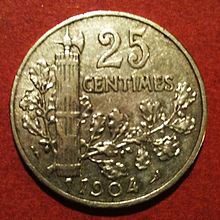Shipping from Europe with tracking number /
Henri-Auguste Patey
Henri Auguste Jules Patey (9 September 1855, Paris – 17 May 1930, Paris) was a French sculptor, medallist and coin engraver.
Life
Patey studied sculpture with Henri Chapu and engraving and medal making with Jules-Clément Chaplain. He was admitted to the École nationale supérieure des Beaux-Arts in 1873. In 1875, he won the second Prix de Rome for medal engraving and in 1881 he won the first Grand prix de Rome, also for medal engraving. He won further prizes in 1886 (third), 1887 (second) and 1894 (first). At the Universal Exhibition of 1889 he won a bronze medal. He produced many portrait medals, not only of clients, but also of relatives and friends. He also authored decorations and patterns.[1]
In 1898, he became a knight of the Légion d'honneur. He was a member of the Académie des Beaux-Arts from 1913.
Henri-Auguste Patey died in 1930.
Works
He succeeded Jean Lagrange as chief engraver of the Paris mint in 1896, a position he held until his death. He used a torch as his privy mark. In this position, Patey designed the nickel 25 Centimes 1903.[2] This piece was generally rejected. It was the first copper-nickel coin in France. The white metal was taken for silver and the coin confused with the 1 franc, in spite of a completely different design. Coins with a different design and shape dated 1904 and 1905 were not accepted either. He did not design any other French coins after this double disappointments. Copper-nickel coins succeeded only in 1914, when holed coins were produced.
Patey was also responsible for the following French colonial and foreign coins:[3]
- Cameroon: 50 centimes, 1 franc, 2 francs 1924-1926
- French Indo China: 5 centimes 1923-1943
- Guadeloupe: 50 centimes, 1 franc 1903, 1921
- Kingdom of Serbs, Croats and Slovenes: 50 para, 1 dinar, 2 dinara, 20 dinara 1925
- Thailand: 1 baht 1908
- Togo: 50 centimes, 1 franc, 2 francs 1924-1926
And possibly coins for the Comoros, Syria and Lebanon struck at the Paris mint.
Henri Jean Baptiste Anatole Leroy-Beaulieu
Henri Jean Baptiste Anatole Leroy-Beaulieu (February 12, 1842 – June 16, 1912) was a French publicist and historian born at Lisieux, Calvados. He specialized in writing about the history of Russia.
Biography
In 1866 he published Une troupe de comédiens, and afterwards Essai sur la restoration de nos monuments historiques devant l'art et devant le budget, which deals particularly with the restoration of the cathedral of Évreux. He visited Russia in order to collect documents on the political and economic organization of the Slavic nations, and on his return published in the Revue des deux mondes (1882–1889) a series of articles, which appeared shortly afterwards in book form under the title L'Empire des tsars et les Russes (4th ed., revised in 3 vols., 1897–1898). The work entitled Un empereur, un roi, un pope, une restauration, published in 1879, was an analysis and criticism of the politics of the Second French Empire. Un homme d'état russe (1884) gave the history of the emancipation of the serfs by Alexander II.
Other works are Les Catholiques libéraux, l'église et la libéralisme (1890), La Papauté, le socialisme at la démocracie (1892), Les Juifs et l'Antisémitisme; Israël chez les Nations (1893), Les Arméniens et la question arménienne (1896), L'Antisémitisme (1897), Etudes russes et européennes (1897). These writings, mainly collections of articles and lectures intended for the general public, display enlightened views and wide information.
In 1881 Leroy-Beaulieu was elected professor of contemporary history and eastern affairs at the École Libre des Sciences Politiques, becoming director of this institution on the death of Albert Sorel in 1906, and in 1887 he became a member of the Académie des Sciences Morales et Politiques.
Four of Leroy-Beaulieu's works have been translated into English:
- Empire of the Tsars and the Russians, by Zénaïde Alexeïevna Ragozin (New York City, 1893–1896)[1]
- Papacy, Socialism, Democracy, by B. L. O'Donnell (1892)
- Israel among the Nations: A Study of the Jews and Antisemitism, by F. Hellman (1895)
- Jewish Immigrants in Early 1900s America, by S. Capsuto (2016)
Also see W. E. H. Lecky, Historical and Political Essays (1908).
His brother, Pierre Paul Leroy-Beaulieu (1843–1916), was a notable French economist.

